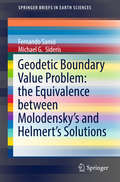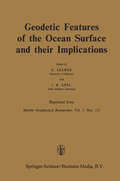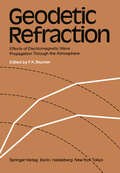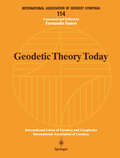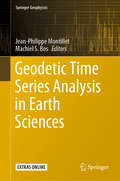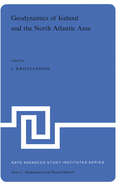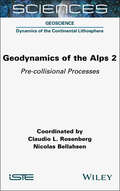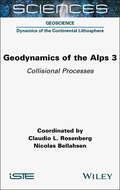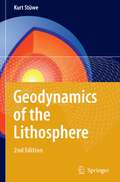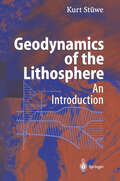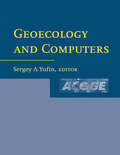- Table View
- List View
Geodetic Boundary Value Problem: The Equivalence Between Molodensky's And Helmert's Solutions (SpringerBriefs in Earth Sciences)
by Fernando Sansò Michael G. SiderisThis book offers a new approach to interpreting the geodetic boundary value problem, successfully obtaining the solutions of the Molodensky and Stokes boundary value problems (BVPs) with the help of downward continuation (DC) based methods. Although DC is known to be an improperly posed operation, classical methods seem to provide numerically sensible results, and therefore it can be concluded that such classical methods must in fact be manifestations of different, mathematically sound approaches. Here, the authors first prove the equivalence of Molodensky’s and Stoke's approaches with Helmert’s reduction in terms of both BVP formulation and BVP solutions by means of the DC method. They then go on to show that this is not merely a downward continuation operation, and provide more rigorous interpretations of the DC approach as a change of boundary approach and as a pseudo BVP solution approach.
Geodetic Deformation Monitoring: IAG Symposium Jaén, Spain, March 7-19,2005 (International Association of Geodesy Symposia #131)
by Fernando Sansò Antonio J. GilGeodesy is the science dealing with the determination of the position of points in space, the shape and gravity field of the Earth and with their time variations. This book collects 36 selected papers from the International Symposium on Geodetic Deformation Monitoring held in Jaén (Spain) from 17th to 19th March 2005. It contains a good overview of theoretical matters, models and results.
Geodetic Features of the Ocean Surface and their Implications
by G. Seeber J. R. ApelThis volume contains most of the papers which were presented at the Interdisciplinary Symposium No. 4 "Geodetic Features of the Ocean Surface and their Implications" during the XVIII. General Assembly of the International Union of Geodesy and Geophysics (IUGG) in Hamburg, August 1983. The symposium was jointly sponsored by the International Associ ation of Geodesy (lAG) and the International Association for the Physi cal Sciences of the Ocean (IAPSO), and was as such one further step in animpQrtant line of international and interdisciplinary symposia, re lated to the field of Marine Geodesy. Originally the term "Marine Geodesy" was widely understood as "Geodesy in the Marine Environment" and dealt primarily with two as pects: precise position determination at sea and determination of a fine structured marine geoid. However, mainly with the impact of satel lite radar altimeter measurements, a new understanding began to develop: it became evident that the field of Marine Geodesy could not be treated adequately from geodesists alone but that it needed close cooperation with related disciplines such as oceanography and marine geophysics. Symposium No. 4 at Hamburg could demonstrate that this coopera tion has already become a lively reality. The "geodetic features of the ocean surface" don't only reflect oceanographical but also marine geo physical aspects. As such scientists from geodesy, oceanography, marine geology and geophysics came together to present their ideas and to dis cuss questions of mutual interest.
Geodetic Reference Frames: IAG Symposium Munich, Germany, 9-14 October 2006 (International Association of Geodesy Symposia #134)
by Hermann DrewesGeodetic reference frames are the basis for The programme of the Symposium was divided three-dimensional, time dependent positioning according to the Sub-commissions, Projects in all global, regional and national networks, in and Study Groups of Commission 1 into eight cadastre, engineering, precise navigation, geo- general themes: information systems, geodynamics, sea level studies, and other geosciences. They are 1. Combination of space techniques necessary to consistently estimate unknown 2. Global reference frames and Earth rotation parameters using geodetic observations, e. g. , 3. Regional reference frames station coordinates, Earth orientation and 4. Interaction of terrestrial and celestial frames rotation parameters. Commission 1 “Reference 5. Vertical reference frames Frames” of the International Association of 6. Ionosphere modelling and analysis Geodesy (IAG) was established within the new 7. Satellite altimetry structure of IAG in 2003 with the mission to 8. Use of GNSS for reference frames study the fundamental scientific problems for the establishment of reference frames. One day of the Symposium was dedicated to a The principal objective of the scientific work joint meeting with the International Congress of the Commission is basic research on: of Federación Internationale des Géomètres - Definition, establishment, maintenance, and (FIG) and the INTERGEO congress of the improvement of geodetic reference frames. German Association of Surveying, Geo- - Advanced development of terrestrial and information and Land Management. The space observation techniques for this contributions presented at this meeting are purpose. integrated into these proceedings.
Geodetic Refraction: Effects of Electromagnetic Wave Propagation Through the Atmosphere
by F. K. BrunnerWith very few exceptions, geodetic measurements use electro magnetic radiation in order to measure directions, distances, time delays, and Doppler frequency shifts, to name the main ter restrial and space observables. Depending on the wavelength of the radiation and the purpose of the measurements, the follow ing parameters of the electromagnetic wave are measured: ampli tude, phase, angle-of-arrival, polarisation and frequency. Ac curate corrections have to be applied to the measurements in order to take into account the effects of the intervening medium between transmitter and receiver. The known solutions use at mospheric models, special observation programs, remote sensing techniques and instrumental methods. It has been shown that the effects of the earth's atmospheric envelope present a fundamental limitation to the accuracy and precision of geodetic measurements. This applies equally to ter restrial and space applications. Instrumental accuracies are al ready below the atmospherically induced limitations, and thus the accuracy demands on the geodetic refraction solutions are entering a new magnitude zone. This monograph is primarily devoted to the properties of the at mospheric effects on various geodetic measurements and to their evaluation. Ten review papers cover the most pressing aspects of the atmospheric effects on geodetic measurement~. Ttiese state of-the art papers were written by eminent specialists in their respective research fields.
Geodetic Theory Today: Third Hotine-Marussi Symposium on Mathematical Geodesy L’Aquila, Italy, May 30–June 3, 1994 (International Association of Geodesy Symposia #114)
by Fernando SansòIn 1954, Antonio Marussi started a series of symposia in Venice. The first three of these covered the entire theoretical definition of 3-D geodesy as delineated in discussions with renowned contemporary scientists, particularly Martin Hotine. After Marussi's death, the symposia were finally named the Hotine-Marussi Symposia and were continued in Italy. The Third Hotine-Marussi Symposium was held in L'Aquila from May 30 to June 3, 1994. It provided geodesists interested in theory and methodology with the opportunity to discuss their theoretical achievements, as well as new topics in the geodetic sciences. This book thus provides an updated overview of the main geodetic theories in various fields of application.
Geodetic Time Series Analysis in Earth Sciences (Springer Geophysics)
by Jean-Philippe Montillet Machiel S. BosThis book provides an essential appraisal of the recent advances in technologies, mathematical models and computational software used by those working with geodetic data. It explains the latest methods in processing and analyzing geodetic time series data from various space missions (i.e. GNSS, GRACE) and other technologies (i.e. tide gauges), using the most recent mathematical models. The book provides practical examples of how to apply these models to estimate seal level rise as well as rapid and evolving land motion changes due to gravity (ice sheet loss) and earthquakes respectively. It also provides a necessary overview of geodetic software and where to obtain them.
Geodynamic Evolution of the Indian Shield: Geophysical Aspects (Society of Earth Scientists Series)
by Om Prakash PandeyThis book addresses time-bound geotectonic evolution of the various geological terrains of the Indian continent, on the basis of integrated geophysical studies, like seismic, seismological, gravity, magnetic, magnetotelluric and heat flow, carried out over the past five decades. Further, it discusses elastic and petrophysical properties of the Earth’s crust relevant to geological investigations. The book also shares latest findings on the geodynamic development of the Indian shield and nearby continental margins, including Arabian Sea.
Geodynamic Evolution of the Southernmost Andes: Connections with the Scotia Arc (Springer Earth System Sciences)
by Matías C. GhiglioneThis book focuses on the strong relation between the tectonic evolution of the Southernmost Andes and their closest southern neighbors, the Scotia Sea and Antarctica. Some episodes are related to processes of global significance such as the opening of the Drake Passage, which is somehow linked to Late Cenozoic cooling. Many of the topics covered in the book are subjects of heated debates; as such, not only the latest data and approaches are presented, but different points of view as well. The chapters examine the interrelation between main geodynamic processes and plate tectonics from a multidisciplinary perspective.This Paleozoic-Cenozoic geodynamic evolution of the Southernmost Andes involved interrelated metamorphic, magmatic, sedimentary, and deformational processes directed by plate tectonics. The main topics cover the evolution of the Rocas Verdes basin and the Cordillera Darwin high-grade metamorphic complex, growth of the Patagonian Batholith, development of the Patagonian Orocline, the opening of the Drake Passage during growth of the Scotia Sea, evolution of the Austral-Magallanes foreland basin and its related fold and thrust belt.
Geodynamics and Earth Tides Observations from Global to Micro Scale (Pageoph Topical Volumes)
by Carla Braitenberg Giuliana Rossi Geodynamics and Earth Tides Editor groupThis volume treats the key aspects that must be known when dealing with continuous space geodetic or terrestrial geodetic observations. The signals of Earth core resonance are discussed, as well as tidal effects on Earth polar motion and on earthquake triggering. Hydrologic loading, be it ocean tides or subsurface water flows, is discussed. These signals compete with crustal deformation observations of earthquakes (e.g., Gorkha 2015) during interseismic periods, and on volcanoes (Elbrus, Caucasus). The instrumentation that is covered includes superconducting gravimeters, continuous seafloor gravimeters, interferometric tilt and strain meters, and GNSS networks.The articles give an up-to-date account of research in which the Earth tides are a benchmark signal for the sophisticated instrumentation mounted on satellites or the surface, observing time-variable signals of an evolving Earth. Scientists studying the earthquake cycle and geodetic monitoring will find useful material. For students in the geosciences, the collection offers a good overview of the broad spectrum of topics related to the Earth geodetic monitoring.
Geodynamics of Azores-Tunisia (Pageoph Topical Volumes)
by E. Buforn J. Martin-Davila A. UdiasThe following four papers deal with the seismicity and seismotectonic of the region. Carrilho et al. present the first results of GEOALGAR, a project initiated in 2000 to monitor the seismic activity in the Algarve region (southern Portugal). In this paper results of the relocation of epicenters and determination of fault plane solutions are presented. The new epicentral locations show a more organized spatial distribution which could indicate a possible correlation with some known tectonic features. Fault plane solutions are predominantly of strike-slip motion consistent with a horizontal compression in the NW-SE to NNW-SSE direction. The paper by Yelles-Chaouche et al. presents a detailed study of the 22 December, 1999 earthquake at Ain Temouchent (northwest Algeria) of magnitude 5. 7. The earthquake caused serious damage in the town of Ain Teemouchent with 25 casualties and 25000 people left homeless. Intensity map, surface features and the focal mechanism, based on wave form analysis, are shown. The mechanism corresponds to reverse fault motion with planes striking NNE-SSW resulting from horizontal compression in the NW-SE direction. This corresponds to the general mechanism found for Algeria earthquakes. Buforn et al. present a study of the characteristics of the plate boundary between Africa and Iberia, from west of Cape San Vicente to Algeria, using seismicity and source mechanism data. The region is divided into three areas which manifest different characteristics.
Geodynamics of Iceland and the North Atlantic Area: Proceedings of the NATO Advanced Study Institute held in Reykjavik, Iceland, 1–7 July, 1974 (Nato Science Series C: #11)
by L. KristjanssonDuring the revolution in earth science that has taken place in recent years, studies of the North Atlantic ocean floor and of Iceland have played an increasingly significant role. Icelandic geoscientists have followed, and taken part in, these studies with a keen interest; one of the first tasks of the Geoscience Society of Iceland was to organize an Icelandic symposium on "Iceland and Mid-Ocean Ridges" in 1967. At the suggestion of Dr. G. Pfuason, the Society and various local research institutions formed in 1972 an Organizing Committee for an international meeting on earth science. It was decided that it should be devoted to examining the various expressions of geo~namical forces in the North Atlantic area, in particular at the ocean ridges passing through Iceland. Apart from the scientific content of such a meeting, the organizers also felt it was highly important for scientists from both sides of the Atlantic to meet in Iceland, to become acquainted with recent progress in earth science research there and to coordinate their future research projects in the area. The meeting was held in Reykj avik 1 - 7 July, 1974, and was followed by field trips in Iceland. Generous financial support from the NATO Scient'ific Affairs Division, the Inter-Union Com mission on Geodynamics, and many other sources, is gratefully acknowledged.
Geodynamics of Lithosphere & Earth’s Mantle: Seismic Anisotropy as a Record of the Past and Present Dynamic Processes (Pageoph Topical Volumes)
by Jaroslava Plomerova Robert C. Liebermann Vladislav BabuskaPlate tectonics has significantly broadened our view of the dynamics of continental evolution, involving both the processes currently active at the surface and those extending deep into the interior of the Earth. Seismic anisotropy provides some of the most diagnostic evidence for mapping past and present deformation of the entire crustmantle system. This volume contains papers presented originally at an international workshop at the Chateau of Trest in the Czech Republic in 1996. This workshop brought together geophysicists and geologists who work in the field of observational and theoretical seismology, mineral and rock physics, gravity studies and geodynamic modelling. Topics include large-scale anisotropy of the Earth's mantle, mantle heterogeneity vs. anisotropy 3-D velocity and density structures and inferences on mantle dynamics, mineral and rock physics studies, and mathematical aspects of complex wave propagation.
Geodynamics of the Alps 1: Present-Structure and Regional Alpine Studies from Extension to Collision
by Claudio L. Rosenberg Nicolas BellahsenGeodynamics of the Alps consists of three volumes. This first volume describes the recent and present-day structure and tectonic setting of the Alpine chain, from the lithospheric mantle to brittle crust and surface topography. It also provides a historical overview of Alpine research, with two chapters covering specific Alpine regions (Corsica and the Eastern Alps) through all phases of Alpine history. The aim of this book is to create a space for experts on Alpine research to present the state of the art of specific subjects and provide their own interpretations.
Geodynamics of the Alps 1: Present-Structure and Regional Alpine Studies from Extension to Collision
by Claudio L. Rosenberg Nicolas BellahsenGeodynamics of the Alps consists of three volumes. This first volume describes the recent and present-day structure and tectonic setting of the Alpine chain, from the lithospheric mantle to brittle crust and surface topography. It also provides a historical overview of Alpine research, with two chapters covering specific Alpine regions (Corsica and the Eastern Alps) through all phases of Alpine history. The aim of this book is to create a space for experts on Alpine research to present the state of the art of specific subjects and provide their own interpretations.
Geodynamics of the Alps 2: Pre-collisional Processes
by Claudio L. Rosenberg Nicolas BellahsenGeodynamics of the Alps consists of three volumes. This second volume presents the pre-collisional history of the Alps. It discusses the Variscan orogeny in the Alpine realm, the inferred paleo-geography, the structure and processes affecting continental margins and the mantle structure in the pre-orogenic Alpine realm. It concludes by describing oceanic and continental subduction processes. The aim of this book is to create a space for experts on Alpine research to present the state of the art of specific subjects and provide their own interpretations.
Geodynamics of the Alps 2: Pre-collisional Processes
by Claudio L. Rosenberg Nicolas BellahsenGeodynamics of the Alps consists of three volumes. This second volume presents the pre-collisional history of the Alps. It discusses the Variscan orogeny in the Alpine realm, the inferred paleo-geography, the structure and processes affecting continental margins and the mantle structure in the pre-orogenic Alpine realm. It concludes by describing oceanic and continental subduction processes. The aim of this book is to create a space for experts on Alpine research to present the state of the art of specific subjects and provide their own interpretations.
Geodynamics of the Alps 3: Collisional Processes
by Claudio L. Rosenberg Nicolas BellahsenGeodynamics of the Alps consists of three volumes. This third volume is entirely dedicated to Alpine collision. It describes and interprets elements of the Alpine chain, including Alpine magmatism, the formation of external massifs, the foreland basin, the exhumation of the internal part of the chain and the northern deformation front of the Alps. The aim of this book is to create a space for experts on Alpine research to present the state of the art of specific subjects and provide their own interpretations.
Geodynamics of the Alps 3: Collisional Processes
by Claudio L. Rosenberg Nicolas BellahsenGeodynamics of the Alps consists of three volumes. This third volume is entirely dedicated to Alpine collision. It describes and interprets elements of the Alpine chain, including Alpine magmatism, the formation of external massifs, the foreland basin, the exhumation of the internal part of the chain and the northern deformation front of the Alps. The aim of this book is to create a space for experts on Alpine research to present the state of the art of specific subjects and provide their own interpretations.
Geodynamics of the Indian Plate: Evolutionary Perspectives (Springer Geology)
by Neal Gupta Sampat K. TandonThis book provides insights on new geological, tectonic, and climatic developments in India through a time progression from the Archean to the Anthropocene that are captured via authoritative entries from experts in earth sciences. This volume aims to bring graduate students and researchers up to date on the geodynamic evolution of the Indian Plate; concepts that have so far resulted in a rather uneven treatment of the subject at different institutions.The book is divided into 4 sections and includes perspectives such as the formation and evolution of the Indian crust in comparison to its neighbors such as Antarctica, Africa and Australia; the evolution of Precambrian cratons and sedimentary basins of India; and a summary account of early life reported in the Indian stratigraphic record. Readers will also discover the key recent research into the neotectonics, tectonic geomorphology, and paleoseismology of the Himalayan Front. Researchers and students in geology, earth sciences, sedimentology, paleobiology and geography will find this book appealing.
Geodynamics of the Latin American Pacific Margin (Pageoph Topical Volumes)
by William L. Bandy Juanjo Dañobeitia Carlos Mortera Gutiérrez Yuri Taran Rafael BartoloméGeodynamics of the Latin American Pacific Margin presents a collection of 22 studies by a multinational group of investigators whose common interest is to better understand the complex geodynamic processes occurring along the Pacific margin of Latin America and the impact that these processes have on the local populace. Processes investigated in these papers include the subduction of buoyant ridges and spreading centers, ophiolite emplacement, plate margin truncation, forearc deformation, mantle convection, magma emplacement and associated continental rifting, and the release of energy by great earthquakes as well as slow slip events. These studies illustrate the vast and varied research opportunities that exist along the margin, and will be a welcome addition to the library of those who are actively investigating the geodynamics of the Latin American Pacific margin as well as those interested in the subduction process in general.
Geodynamics of the Lithosphere: An Introduction
by Kurt StüweThis second edition of the important introductory text for earth scientists has been thoroughly revised and extended. It is required reading for all those interested in learning about the quantitative description of geological problems. It contains chapters on heat flow, sedimentary basin modeling, the mechanics of continental deformation, PT path modeling, geomorphology, mass transfer and more. The book is aimed at the field oriented geologist who wants to begin by learning about the quantitative description of problems. The new edition features yet more illustrations and maps as well as almost 100 corrections of scientific problems.
Geodynamics of the Lithosphere
by Kurt StüweThe large scale structure of the earth is caused by geodynamic processes which are explained using energetic, kinematic and dynamic descriptions. While "geodynamic processes" are understood to include a large variety of processes and the term is used by earth scientists quite loosely, the methods of their description involve well defined fields. Energetic descriptions are in volved with distribution of energy in our planet, typically expressed in terms of heat and temperature. Kinematic descriptions describe movements using velocities, strains and strain rates and Dynamic descriptions indicate how stresses and forces behave. As structural and metamorphic geologists we document in the field only the consequences of geological processes. The underlying causes are much harder to constrain directly. However, it is absolutely crucial to understand these causes or: "driving forces", if we are to explain the tectonic evolution of our planet. This book deals with the dynamic description of geological processes. Our descriptions relate causes and consequences - tectonic processes with field observations. In many cases, we will use equations as a concise form to describe processes and observations in nature. As we will be dealing mostly with large scale tectonic questions, the observations that we shall use are also on a large scale. For example, we shall use observations on the elevation (Fig. 1.1, 1.2) and heat flow of mountain ranges, the thickness of continents and the water depth of the oceans.
Geoecological Risk Management in Polar Areas (Environmental Pollution #28)
by Vladimir N. Bashkin Rauf V. GaliulinThis monograph is devoted to full-scale geoecological risk assessment in gas industry impacted polar areas and the relevant risk management options using innovative nature-like biogeochemical technologies. Readers will discover more about geoecological risks during gas production, transportation, storage and refining.Chapters discuss in detail the geodynamic dangers associated with the designing and building of main gas pipelines. The book has interdisciplinary appeal, and specialists and practitioners in environmental sciences, ecology, biogeochemistry and those within the energy sector who are interested in understanding ecosystems affected by anthropogenic impacts in severe climatic conditions will find it particularly engaging. Through this book, readers will learn more about recultivation of contaminated soils as well as health risk assessments of chemical substances associated with the gas industry.
Geoecology and Computers
by Sergey A. YufinThis volume presents technical papers devoted to development and practical use of computer methods in geotechnical and geoenviromental engineering. It covers issues on space use and construction, soil and rock mechanics, and mining applications amongst other topics.
